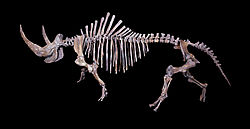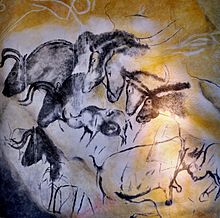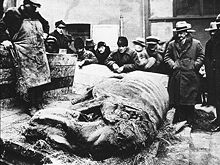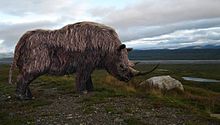- Woolly rhinoceros
-
Woolly rhinoceros
Temporal range: Middle to Late Pleistocene[1], 0.35–0.01 Ma
Woolly rhinoceros (Coelodonta antiquitatis) skeleton on display Scientific classification Kingdom: Animalia Phylum: Chordata Class: Mammalia Order: Perissodactyla Family: Rhinocerotidae Genus: †Coelodonta
Bronn, 1831Species: †C. antiquitatis Binomial name Coelodonta antiquitatis
(Blumenbach, 1807)The woolly rhinoceros (Coelodonta antiquitatis) is an extinct species of rhinoceros that was common throughout Europe and Asia[1] during the Pleistocene epoch and survived the last glacial period. The genus name Coelodonta means "cavity tooth". The woolly rhinoceros was a member of the Pleistocene megafauna.
Recently, the oldest known woolly rhinoceros fossil was discovered from 3.6 million years in the Himalayas on the cold Tibetan Plateau, suggesting it existed there during a period of general climate warmth around the earth. It is believed that they migrated from there to northern Asia and Europe when the Ice Age began.[2]
Contents
Appearance
The external appearance of woolly rhinos is known from mummified individuals from Siberia as well as cave paintings.[3] An adult woolly rhinoceros was 3 to 3.8 metres (10 to 12.5 feet) in length, and 2 to 3 tons on average,[1] but they could probably grow to 4.3 - 4.4 meters (over 14 feet) at the largest.[citation needed] The woolly rhinoceros could grow up to be 2 meters tall.[1] Two horns on the skull were made of keratin, the anterior horn being 2 feet in length,[4] with a smaller horn between its eyes. It had thick, long fur, small ears, short, thick legs, and a stocky body. Cave paintings suggest a wide dark band between the front and hind legs, but it is not universal and identification of rhinoceros as woolly rhinoceros is uncertain. The woolly rhinoceros used its horns for defensive purposes and to attract mates.
As the last and most derived member of the Pleistocene rhinoceros lineage, the woolly rhinoceros was supremely well adapted to its environment. Stocky limbs and thick woolly pelage made it well suited to the steppe-tundra environment prevalent across the Palearctic ecozone during the Pleistocene glaciations. Its geographical range expanded and contracted with the alternating cold and warm cycles, forcing populations to migrate as glaciers receded. Like the vast majority of rhinoceroses, the body plan of the woolly rhinoceros adhered to the conservative morphology, like the first rhinoceroses seen in the late Eocene. A close relative, the Elasmotherium had a more southern range.
Diet
Controversy has long surrounded the precise dietary preference of Coelodonta as past investigations have found both grazing and browsing modes of life to be plausible. The palaeodiet of the woolly rhinoceros has been reconstructed using several lines of evidence. Climatic reconstructions indicate the preferred environment to have been cold and arid steppe-tundra, with large herbivores forming an important part of the feedback cycle. Pollen analysis shows a prevalence of grasses and sedges within a more complicated vegetation mosaic.[citation needed]
A strain vector biomechanical investigation of the skull, mandible and teeth of a well-preserved last cold stage individual recovered from Whitemoor Haye, Staffordshire, revealed musculature and dental characteristics that support a grazing feeding preference. In particular, the enlargement of the temporalis and neck muscles is consistent with that required to resist the large tugging forces generated when taking large mouthfuls of fodder from the ground. The presence of a large diastema supports this theory.
Comparisons with extant perissodactyls confirm that Coelodonta was a hindgut fermentor with a single stomach, and as such would have grazed upon cellulose-rich, protein-poor fodder. This method of digestion would have required a large throughput of food and thus links the large mouthful size to the low nutritive content of the chosen grasses and sedges.[5]
Extinction
Main article: Pleistocene megafaunaMany species of Pleistocene megafauna, like the woolly rhinoceros, became extinct around the same time period. Human and Neanderthal hunting is often cited as one cause.[6] Other theories for the cause of the extinctions are climate change associated with the receding Ice age and the hyperdisease hypothesis.[7]
Its shape was known only from prehistoric cave drawings until a completely preserved specimen (missing only the fur and hooves) was discovered in a tar pit in Starunia, Poland. The specimen, an adult female, is now on display in the Polish Academy of Sciences' Museum of Natural History in Kraków. The woolly rhinoceros roamed much of Northern Europe and was common in the then cold, arid desert that is southern England and the North Sea today. During Greenland Stadial 2 (the Last Glacial Maximum) the North Sea did not exist as sea levels were up to 125 metres (410 ft) lower than today.
 Restoration by Charles R. Knight
Restoration by Charles R. Knight
The woolly rhinoceros co-existed with woolly mammoths and several other extinct larger mammals.
Recent radiocarbon dating indicates that populations survived as recently as 8,000 B.C. in western Siberia. However, the accuracy of this date is uncertain as several radiocarbon plateaus exist around this time. The extinction does not coincide with the end of the last ice age but does coincide however, with a minor yet severe climatic reversal that lasted for about 1,000–1,250 years, the Younger Dryas (GS1 - Greenland Stadial 1), characterized by glacial readvances and severe cooling globally, a brief interlude in the continuing warming subsequent to the termination of the last major ice age (GS2), thought to have been due to a shutdown of the thermohaline circulation in the ocean due to huge influxes of cold fresh water from the preceding sustained glacial melting during the warmer Interstadial (GI1 - Greenland Interstadial 1 - ca. 16,000 - 11,450 14C years B.P.).
References
- Parker, Steve. Dinosaurus: the complete guide to dinosaurs. Firefly Books Inc, 2003. Pg. 422
- ^ a b c d Woolly Rhino (Coelodonta antiquitatis) International Rhino Foundation. Retrieved October 30, 2011.
- ^ "Ice Age giants may have evolved in Tibet". CNN. 1 September 2011. http://lightyears.blogs.cnn.com/2011/09/01/ice-age-giants-may-have-evolved-in-tibet.
- ^ Frozen Fauna of the Mammoth Steppe
- ^ Haines, Tim; Chambers, Paul (2005). "Coelodonta". The complete guide to prehistoric life (First ed.). Buffalo, N.Y.: Firefly Books. p. 203. ISBN 9781554071814.
- ^ SAS Bulletin, Volume 26, number 3/4, Winter 2003 from the Society for Archaeological Sciences
- ^ Diamond, Jared (1997). Guns, Germs and Steel. New York: Vintage. ISBN 0099302780.
- ^ Grayson, D. K.; Meltzer, D. J. (2003). "A requiem for North American overkill". Journal of Archaeological Science 30: 585–593. doi:10.1016/S0305-4403(02)00205-4. http://www.unl.edu/rhames/courses/current/requiem-overkill.pdf.
External links
Categories:- Prehistoric rhinoceroses
- Pleistocene mammals
- Pliocene mammals
- Pleistocene extinctions
- Prehistoric mammals of Europe
Wikimedia Foundation. 2010.





